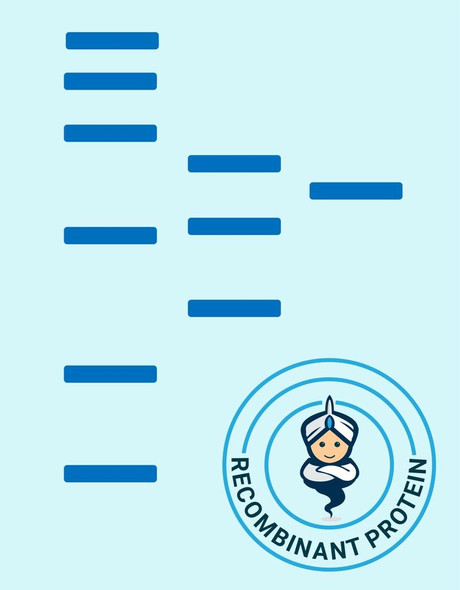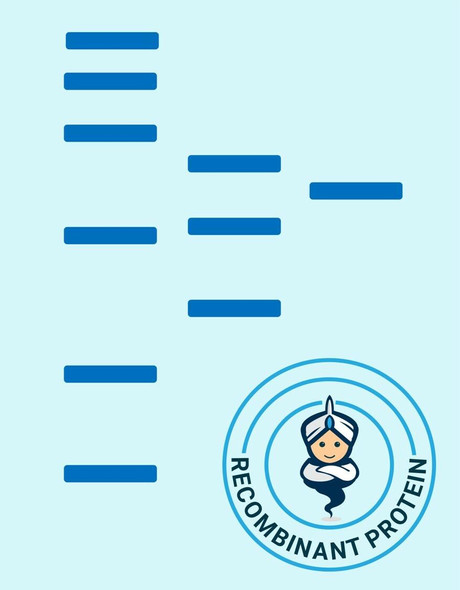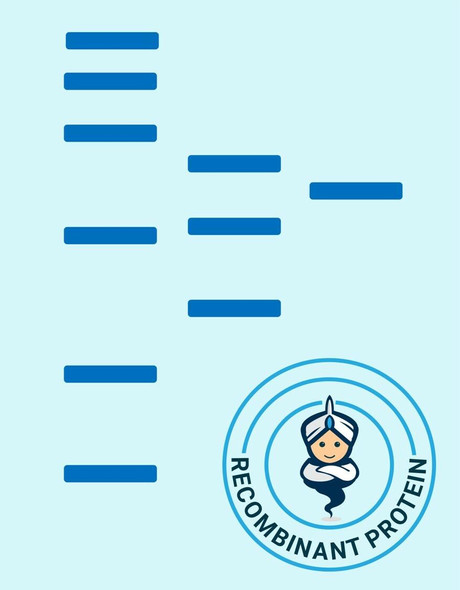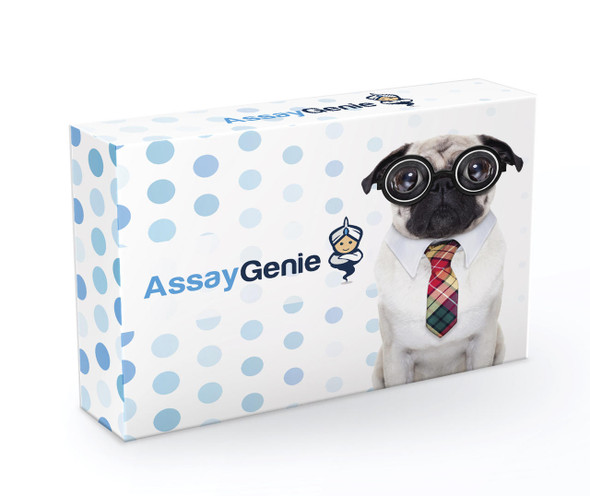Description
| Product Name: | Human PF 4 Recombinant Protein |
| Product Code: | RPPB1235 |
| Size: | 20µg |
| Species: | Human |
| Target: | PF 4 |
| Synonyms: | CXCL4, PF-4, PF4, Iroplact, Oncostatin-A, SCYB4, MGC138298. |
| Source: | Escherichia Coli |
| Physical Appearance: | Sterile Filtered white lyophilized powder. |
| Formulation: | The CXCL4 protein was lyophilized after extensive dialysis against 50mM Tris-HCl pH 8.0 and 150mM NaCl buffer. |
| Solubility: | It is recommended to reconstitute the lyophilized CXCL4 in sterile 18M?-cm H2O not less than 100�g/ml, which can then be further diluted to other aqueous solutions. |
| Stability: | Lyophilized CXCL4 although stable at room temperature for 3 weeks, should be stored desiccated below -18°C. Upon reconstitution CXCL4 should be stored at 4°C between 2-7 days and for future use below -18°C.For long term storage it is recommended to add a carrier protein (0.1% HSA or BSA).Please prevent freeze-thaw cycles. |
| Purity: | Greater than 95.0% as determined by:(a) Analysis by RP-HPLC.(b) Analysis by SDS-PAGE. |
| Amino Acid Sequence: | The sequence of the first four N-terminal amino acids was determined and was found to be Glu-Ala-Glu-Glu-Asp |
| Biological Activity: | The ED50 of CXCL4 as determined by its ability to inhibit human FGF basic dependent proliferation of NR6R3T3 mouse fibroblasts was found to be 5-15 ?g/ml. |
Platelet factor-4 is a 70-amino acid protein that is released from the alpha-granules of activated platelets. Its major physiologic role appears to be neutralization of molecules on the endothelial surface of blood vessels, thereby inhibiting local antithrombin III activity and promoting coagulation. As a strong chemoattractant for neutrophils and fibroblasts, PF4 probably has a role in inflammation and wound repair. Oncostatin-A is a member of the CXC chemokine family. Furthermore it is used as an inhibitor in the angiogenesis during tumor therapy.
CXCL4 Human Recombinant produced in E.Coli is a single, non-glycosylated polypeptide chain containing 70 amino acids and having a molecular mass of 7.8 kDa.
| UniProt Protein Function: | PF4: Released during platelet aggregation. Neutralizes the anticoagulant effect of heparin because it binds more strongly to heparin than to the chondroitin-4-sulfate chains of the carrier molecule. Chemotactic for neutrophils and monocytes. Inhibits endothelial cell proliferation, the short form is a more potent inhibitor than the longer form. Belongs to the intercrine alpha (chemokine CxC) family. |
| UniProt Protein Details: | Protein type:Motility/polarity/chemotaxis; Apoptosis; Secreted, signal peptide; Chemokine; Secreted Chromosomal Location of Human Ortholog: 4q12-q21 Cellular Component: extracellular space; extracellular region Molecular Function:heparin binding; CXCR3 chemokine receptor binding; chemokine activity Biological Process: negative regulation of cytolysis; platelet activation; leukocyte chemotaxis; cytokine and chemokine mediated signaling pathway; positive regulation of leukocyte chemotaxis; response to lipopolysaccharide; positive regulation of cAMP metabolic process; positive regulation of tumor necrosis factor production; negative regulation of megakaryocyte differentiation; regulation of cell proliferation; G-protein coupled receptor protein signaling pathway; negative regulation of angiogenesis; platelet degranulation; negative regulation of MHC class II biosynthetic process; positive regulation of transcription from RNA polymerase II promoter; immune response; positive regulation of macrophage differentiation; inflammatory response; blood coagulation |
| NCBI Summary: | This gene encodes a member of the CXC chemokine family. This chemokine is released from the alpha granules of activated platelets in the form of a homotetramer which has high affinity for heparin and is involved in platelet aggregation. This protein is chemotactic for numerous other cell type and also functions as an inhibitor of hematopoiesis, angiogenesis and T-cell function. [provided by RefSeq, Mar 2012] |
| UniProt Code: | P02776 |
| NCBI GenInfo Identifier: | 130304 |
| NCBI Gene ID: | 5196 |
| NCBI Accession: | P02776.2 |
| UniProt Secondary Accession: | P02776,Q53X61, Q9UC64, Q9UC65, |
| UniProt Related Accession: | P02776 |
| Molecular Weight: | 10,845 Da |
| NCBI Full Name: | Platelet factor 4 |
| NCBI Synonym Full Names: | platelet factor 4 |
| NCBI Official Symbol: | PF4�� |
| NCBI Official Synonym Symbols: | PF-4; CXCL4; SCYB4�� |
| NCBI Protein Information: | platelet factor 4; iroplact; oncostatin-A; C-X-C motif chemokine 4; chemokine (C-X-C motif) ligand 4 |
| UniProt Protein Name: | Platelet factor 4 |
| UniProt Synonym Protein Names: | C-X-C motif chemokine 4; Iroplact; Oncostatin-ACleaved into the following chain:Platelet factor 4, short form |
| Protein Family: | Platelet factor |
| UniProt Gene Name: | PF4�� |
| UniProt Entry Name: | PLF4_HUMAN |










